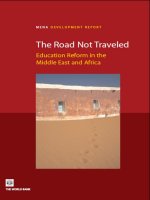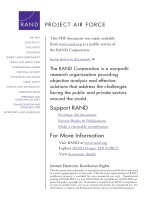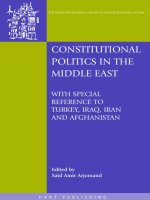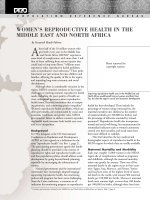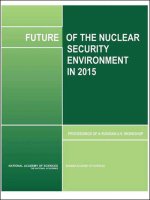The Future Security Environment in the Middle East - Conflict, Stability, and Political Change pptx
Bạn đang xem bản rút gọn của tài liệu. Xem và tải ngay bản đầy đủ của tài liệu tại đây (850.47 KB, 365 trang )
Edited by Nora Bensahel and Daniel L. Byman
Prepared for the
United States Air Force
Approved for Public Release; Distribution Unlimited
R
Project AIR FORCE
The Future
Security Environment
in the Middle
East
Conflict, Stability, and Political Change
The RAND Corporation is a nonprofit research organization providing
objective analysis and effective solutions that address the challenges
facing the public and private sectors around the world. RAND’s
publications do not necessarily reflect the opinions of its research clients
and sponsors.
R
®
is a registered trademark.
© Copyright 2004 RAND Corporation
All rights reserved. No part of this book may be reproduced in any form
by any electronic or mechanical means (including photocopying,
recording, or information storage and retrieval) without permission in
writing from RAND.
Published 2004 by the RAND Corporation
1700 Main Street, P.O. Box 2138, Santa Monica, CA 90407-2138
1200 South Hayes Street, Arlington, VA 22202-5050
201 North Craig Street, Suite 202, Pittsburgh, PA 15213-1516
RAND URL: />To order RAND documents or to obtain additional information, contact
Distribution Services: Telephone: (310) 451-7002;
Fax: (310) 451-6915; Email:
Cover design by Stephen Bloodsworth
The research reported here was sponsored by the United States Air
Force under Contract F49642-01-C-0003. Further information may
be obtained from the Strategic Planning Division, Directorate of
Plans, Hq USAF.
Library of Congress Cataloging-in-Publication Data
Bensahel, Nora, 1971-
The future security environment in the Middle East : conflict, stability, and
political change / Nora Bensahel, Daniel L. Byman.
p. cm.
Includes bibliographical references.
“MR-1640.”
ISBN 0-8330-3290-9 (pbk. : alk. paper)
1. Middle East—Strategic aspects. 2. United States—Military policy. I.
Byman, Daniel, 1967– II.Title.
UA832.B45 2003
355' 033056—dc22
2003020980
iii
PREFACE
This collection of papers examines emerging security trends that will
shape the Persian Gulf in the coming years. The authors address a
number of topics that will affect regional security, including
prospects for economic and political reform, civil-military relations,
regime change, energy security, the spread of new information tech-
nologies, and the proliferation of weapons of mass destruction. The
volume aims to help policymakers and the public develop a better
understanding of the underlying issues at work in a region at the
forefront of concern today.
Readers of this report may also be interested in a related publication:
Daniel Byman and John R. Wise, The Persian Gulf in the Coming
Decade: Trends, Threats, and Opportunities, RAND Corporation, MR-
1528-AF, 2002. This volume examines likely challenges to U.S.
interests in the Persian Gulf region in the next decade, with principal
focus on the conventional military strength of Iran and Iraq, the
potential for subversion, and the social and economic weaknesses of
the regional states. (Research for MR-1528-AF was completed before
the September 11, 2001, attacks.)
The research reported here was sponsored by the Director of
Operational Plans, Office of the Deputy Chief of Staff for Air and
Space Operations (HQ USAF/XOX), and conducted within the
Strategy and Doctrine Program of RAND Project AIR FORCE.
Comments are welcomed and may be addressed to the acting
Program Director, Alan Vick.
iv The Future Security Environment in the Middle East
RAND PROJECT AIR FORCE
RAND Project AIR FORCE (PAF), a division of the RAND Corporation,
is the U.S. Air Force’s federally funded research and development
center for studies and analyses. PAF provides the Air Force with in-
dependent analyses of policy alternatives affecting the development,
employment, combat readiness, and support of current and future
aerospace forces. Research is conducted in four programs:
Aerospace Force Development; Manpower, Personnel, and Training;
Resource Management; and Strategy and Doctrine.
Additional information about PAF is available on our web site at
/>v
CONTENTS
Preface iii
Tables xi
Summary xiii
Acknowledgments xix
Chapter One
INTRODUCTION
Nora Bensahel and Daniel L. Byman 1
U.S. Interests in the Middle East 2
Countering Terrorism 2
Countering WMD Proliferation 3
Maintaining Stable Oil Supplies and Prices 3
Ensuring the Stability of Friendly Regimes 4
Ensuring Israel’s Security 4
Promoting Democracy and Human Rights 5
Potential Threats to U.S. Interests 7
A Changing Region 9
The Shadows of September 11 and the War Against Iraq 10
Report Objectives and Structure 11
Chapter Two
POLITICAL REFORM IN THE MIDDLE EAST
Nora Bensahel 15
U.S. Interests in Middle Eastern Political Reform 17
Pressures for Political Reform in the Middle East 20
Economic Challenges 20
Demographic Trends 21
vi The Future Security Environment in the Middle East
Accountability and Corruption 23
Possible Regime Responses 24
Regional Trends 25
Democratization: Legislatures 25
Democratization: Consultative Councils 27
Liberalization: Political Parties 28
Liberalization: Civic Organizations 29
Liberalization: Freedom of the Press 32
Liberalization: The Judiciary and the Rule of Law 33
Survey of Key States 34
Egypt 35
Iran 39
Jordan 43
Kuwait 46
Saudi Arabia 48
Impact on U.S. Security Interests 52
Effect on Regional Stability 52
Sensitivity to U.S. Ties 55
Conclusion 55
Chapter Three
ECONOMIC REFORM IN THE MIDDLE EAST: THE
CHALLENGE TO GOVERNANCE
Alan Richards 57
The Key Economic Challenges Facing the Region 61
Restoring Economic Growth 61
Restraining Population Expansion 64
Providing Jobs 66
Alleviating Poverty 68
The Jungle of Cities 72
Saving Water 74
Obtaining Food 75
Attracting Money for Investment 76
Egypt 78
The Background of Reform 79
The Promise of Reform 81
The Performance 82
The Political Economy of “Creeping Cronyism” 86
Jordan 89
Economic Reform in Jordan 95
Crafting Credible Reforms 96
Contents vii
Iran 99
Saudi Arabia 107
The Development of a State-Centered Political
Economy 110
Pressures for Reform 111
Further Obstacles to the Reform Process 114
Syria 117
Riding the Roller Coaster of Rents 119
The Limits of Reform 122
Implications 124
Relatively Advanced Countries 124
Low-Income Countries 126
Oil-Rich Countries 126
Conclusion 128
Chapter Four
CIVIL-MILITARY RELATIONS IN THE MIDDLE EAST
Risa Brooks 129
From Coups to Stability 130
The Ingredients of Political Control 132
Social Support 132
Stacking the Deck 133
Servicing the Military Constituency 134
Internal Security Agencies 135
Dual Militaries 136
Size 138
Institutional Tactics 138
Leader Incentives 139
Political Control and Military Effectiveness 141
Command and Control 141
Leadership 144
Intelligence and Information 146
Potential Offsets to Politicization 147
Centralized Command Structures 148
Technology 148
Specialization and the Internal/External Division of
Labor 150
International Factors 152
The Unconventional Alternative 152
Potential Challenges to Civil-Military Relations 153
Implications for the United States 159
viii The Future Security Environment in the Middle East
Chapter Five
THE IMPLICATIONS OF LEADERSHIP CHANGE IN THE
ARAB WORLD
Daniel L. Byman 163
Parameters of Regime Change 166
Categories of Regime Change 167
Leadership Change in Saudi Arabia 168
Change Within the Al Saud 169
Constants in Saudi Society 173
Saudi Islamists 174
Geopolitical Constants 176
Implications 176
Leadership Change in Syria 177
Bashar Versus Hafez 178
A Shift from Bashar to Other Domestic Actors 181
Geopolitical Constants 183
Implications 184
Leadership Change in Egypt 185
Change Within the Egyptian Elite 185
Geopolitical and Societal Constants 187
The Islamist Alternative 188
Implications 190
Preparing for Regime Change 192
Potential Risks and Opportunities 192
Recommendations 193
Chapter Six
ENERGY AND MIDDLE EASTERN SECURITY: NEW
DIMENSIONS AND STRATEGIC IMPLICATIONS
Ian O. Lesser 197
World Energy Trends and the Energy Security Debate 200
The Outlook for Oil Supply and Price 202
The Aftermath of September 11 and the War in Iraq 204
Changing Patterns of Dependence 205
Emerging Issues 208
The Rise of Gas 208
New Lines of Communication for Oil 213
“Rogue” (or Isolated) States, Sanctions, and Energy
Supply 214
Arms and Oil 216
Contents ix
Energy Prices, Regime Stability, and Military
Potential 218
Energy Denial as an Asymmetric Strategy 219
Transatlantic and Asian Perspectives 222
Conclusions and Policy Implications 223
Chapter Seven
THE INFORMATION REVOLUTION AND THE MIDDLE
EAST
Jon B. Alterman 227
A Richer Information Environment 228
Newspapers 228
Television 231
A Wide Spectrum of Content 235
The Internet 236
The Rise of Mid-Technology 238
Greater Information Diversity and Access 239
Limited Assimilation of High-Technology 240
Implications 243
New Mass Politics 243
Challenges for Regional Governments 245
Implications for the United States 247
Chapter Eight
WEAPONS OF MASS DESTRUCTION IN THE MIDDLE
EAST: PROLIFERATION DYNAMICS AND STRATEGIC
CONSEQUENCES
Ian O. Lesser 253
Assessing Recent Trends 257
Algeria 259
Libya 259
Egypt 261
Israel 262
Syria 263
Iran 264
Saudi Arabia 265
Transforming Developments and Synergies 265
Proliferation Motives and Internal Dynamics 268
The Search for Weight and Prestige 268
Countering Western Superiority 271
x The Future Security Environment in the Middle East
Indigenous Development and International Trade 273
Institutional and Domestic Factors 275
Regional Dynamics 277
Geography Matters 277
North-South Frictions and Regional Balances 279
The Arab-Israeli Conflict 281
Gulf Security 283
North Africa 284
Extraregional Dynamics 285
The Russian Factor 286
China and North Korea 288
India, Pakistan, and Proliferation Alliances 289
Implications for European Security 291
A World of Defenses: Implications for the Middle East 293
Conclusions and Policy Implications 296
Chapter Nine
CONCLUSIONS
Nora Bensahel, Daniel L. Byman, and
Negeen Pegahi 299
Tensions Affecting U.S. Foreign Policy 299
Stability Versus Political Reform 300
Regimes Versus Populations 301
Emerging Challenges 303
Political Challenges 303
Military Challenges 305
Key Uncertainties 307
The Price of Oil 307
The Future of Iraq 309
The Arab-Israeli Conflict 310
The Policies of Russia and China 312
The Nature of Regime Change 314
Final Words 315
Bibliography 317
xi
TABLES
1.1. Past Challenges to U.S. Interests in the Middle East 7
2.1. Population Growth Rates and Percentage of
Population Under Age 14 22
2.2. Benefits and Limits of Political Reform in the Middle
East 35
2.3. Iranian Political Reform Trends Since 1997 43
3.1. Unemployment in the Middle East: A Compendium
of Estimates 67
3.2. Budgetary Deficit as a Percentage of GDP 112
5.1. Heads of State of Selected Middle Eastern
Countries 164
xiii
SUMMARY
Since the end of the 1991 Gulf War, threats to political security in the
Middle East have increased. Tensions between states have long
threatened to destabilize the region. At times these tensions have re-
sulted in open warfare, disrupting political and economic security
and creating humanitarian crises. Today, the threat of interstate ag-
gression is manifested in new and more dangerous ways. The col-
lapse of the Arab-Israeli peace process and the subsequent outbreak
of violence have inflamed anti-Western sentiment throughout the
region. The proliferation of weapons of mass destruction (WMD) has
also raised the potential for conflict between rival countries. The ex-
portation of Middle East terrorism around the world has contributed
to the political and economic isolation of the region.
Domestic developments over the past decade could also contribute
to the destabilization of the region. A new generation of leaders has
begun to take power with untested leadership skills and uncertain
bases of support. Education among women has increased, present-
ing a challenge to traditional social hierarchies. Information tech-
nologies such as satellite television have become more available,
providing populations with diverse views on political and social is-
sues. Together these developments could bring about major politi-
cal, social, and economic changes. The long-term effects of such
changes may be positive from the perspectives of democratization
and the advance of human rights. However, the short-term effects
could spell political and economic turmoil, increased threat of con-
flict, and unpredictable shifts in policy and behavior by individual
states.
xiv The Future Security Environment in the Middle East
POLITICAL INSTABILITY IN THE MIDDLE EAST COULD
HAVE SERIOUS CONSEQUENCES FOR THE UNITED STATES
Since the terrorist attacks of September 11, 2001, the Middle East has
played a more prominent role in U.S. policy than ever before. The
United States relies on Middle Eastern partners such as Israel, Saudi
Arabia, Qatar, Egypt, and others to fight terrorism and to halt the
proliferation of WMD by rogue states. The loss of key partners due to
hostile regime changes or increasing anti-Americanism could limit
the United States’ ability to fight terrorism within the region. In ad-
dition, the United States has an interest in maintaining stable energy
prices and reliable supplies. Given the West’s dependence on Middle
East oil, political instability in the region could hurt economies
around the world.
EMERGING TRENDS WILL INCREASE THE POTENTIAL FOR
DESTABILIZATION
What are the prospects for political security in the Middle East in the
foreseeable future? RAND Project AIR FORCE studied current polit-
ical, economic, and social trends in the Middle East to forecast future
threats to regional security and their potential impact on the United
States. Key findings include the following:
• Liberalization will advance slowly and democratization will be
even more limited. Middle East states are typically controlled by
authoritarian, nondemocratic regimes. In recent years, these
regimes have come under pressure to reform the political system
and to relax government controls over the media and other forms
of public expression. Some states have responded to this pres-
sure by allowing liberalization—the introduction of civil liberties
such as free speech and freedom of assembly—but have limited
democratization—the development of democratic institutions
such as elections and representative legislature. For example,
some states allow citizens to participate in civic organizations
that remain tied to the state and do not represent grassroots in-
terests. Despite these limitations, however, continued liberal-
ization may fuel the public appetite for political reform and may
lead to more long-term democratic change. (See pages 15–55.)
Summary xv
• Declining economies will likely increase popular dissatisfaction
with governments. Recent economic reform efforts have failed
to create jobs or to attract foreign investment to the Middle East.
Heavy debt, overtaxation, and government corruption have pre-
vented economic growth. The region currently suffers from un-
employment, poverty, and heavy demands on both clean water
and domestic food supplies. High population growth will exac-
erbate these problems in the coming years. Countries will need
to import more food and will have to invest in expensive water
reclamation technologies. Continued economic decline will
erode public confidence in leaders and will increase the potential
for unrest. Moreover, the surplus of educated youths without
jobs will provide fertile ground for radical fundamentalism to
grow. At the same time, the reforms that would need to take
place to improve economies—such as fewer government regula-
tions and greater accountability—could destabilize regimes by
alienating special-interest constituencies. (See pages 57–128.)
• Militaries will be more devoted to internal control than to exter-
nal defense. Many Middle East states have “dual mandate” mili-
taries responsible for protecting their regimes from internal chal-
lenges as well as defending their countries from external dangers.
As economic and social pressures cause domestic threats to in-
crease, militaries will have to commit their best resources to in-
ternal police functions such as suppressing demonstrations.
Regimes will seek to consolidate control and will be less willing
to grant power to frontline commanders. As a result, military
forces will become less effective at external defense. This trend
will have mixed implications for the United States. The persis-
tence of civil control over the military will mean that U.S. allies in
the region will possess the means to suppress terrorist groups
within their borders. At the same time, these partners will be less
effective in combat operations. (See pages 129–162.)
• New leaders may be weaker and less likely to cooperate with the
United States. Since 1997, new leaders have come to power in
Iran, Algeria, Bahrain, Jordan, Morocco, and Syria. Further lead-
ership changes are expected in Saudi Arabia and Egypt in the
near future. Incoming leaders will need to concentrate on
building popular support for their regimes. They may therefore
be less willing to continue unpopular policies such as cooperat-
xvi The Future Security Environment in the Middle East
ing with the U.S. war on terrorism or supporting Arab conces-
sions to Israel in future peace negotiations. Furthermore, inex-
perienced leaders will be more likely to make mistakes in foreign
policy, whether by overestimating their countries’ military
strength, by believing that they can intimidate their adversaries,
or by trusting in international support that proves to be unreli-
able. These political miscalculations could lead to increased
tensions between states. (See pages 163–195.)
• Changing patterns in the energy market will strengthen Middle
East ties to Asia. The Middle East dominates the global energy
market with roughly 70 percent of the world’s proven oil reserves.
The region is expected to maintain its preeminence through new
exploration and increases in production capacity. However, the
United States and Europe are expected to shift the majority of
their consumption from Middle Eastern oil to Russian oil in the
coming years. Asia will become the leading consumer of oil from
the Middle East. This shift could have important political
implications for the West. China, North Korea, and Russia are
among the leading suppliers of WMD and missile technologies.
As Asian energy demands increase, the defense trade between
Asia and the Middle East is likely to grow. As a result, the United
States will find it more difficult to pressure Asian governments
not to export arms to hostile Middle East regimes. (See pages
197–225.)
• Communications technologies may increase the demand for
public participation in government. Advanced technologies
such as the Internet are primarily limited to the wealthier and
more educated echelons of Middle Eastern society. However,
mid-level technologies such as satellite television, videocas-
settes, fax machines, and photocopiers have become widespread
among the general population. These technologies could have a
profound impact on the political landscape. They permit the
quick and inexpensive circulation of printed materials that are
beyond the control of government media and publishing mo-
nopolies. Satellite television gives people access to Western me-
dia. These innovations provide the population with diverse
views on politics and world events. They also provide forums for
greater discussion and debate. One possible outcome of this
change is that Middle Eastern governments will be compelled to
Summary xvii
take greater steps to eradicate corruption, to bring transparency
to the government process, and to increase standards of living.
However, it is equally possible that governments will respond by
becoming more authoritarian. Regimes may attempt to silence
dissenting voices through intimidation or force. They may also
attempt to limit popular access to certain technologies. (See
pages 227–251.)
• Middle East states will continue to develop and acquire WMD.
WMD capabilities in the region have increased in recent decades,
though not at the rate originally feared by Western analysts.
Nevertheless, many regimes seek to develop or acquire chemical,
biological, radiological, or nuclear weapons and advanced deliv-
ery systems. It is possible that states such as Iran will develop
nuclear weapons capabilities within the next decade. Continued
proliferation of WMD in the Middle East would have serious
implications both within the region and around the world. The
geographical distance between adversaries in the Middle East is
very short. States would not need long-range delivery systems to
inflict sudden and catastrophic damage upon each other. The
expansion of WMD capability in the Middle East would also
constrain U.S. freedom of action by increasing the vulnerability
of deployed forces. Finally, the proliferation of WMD among
Middle East terrorist groups could threaten the U.S. homeland.
The September 11 attacks demonstrate the global reach of cer-
tain groups and their willingness to stage large-scale offensives
against the United States. (See pages 253–298.)
THE UNITED STATES MUST BALANCE OPPOSING INTER-
ESTS IN FORMING MIDDLE EAST POLICY
Given the range of potential crises that could emerge in the Middle
East, the United States must carefully consider which policies are
likely to produce the best outcome. A critical issue is whether the
United States should promote political stability or whether it should
encourage democratic reform. Experience in the former Soviet
Union and elsewhere suggests that states undergoing the transition
to democracy are more likely to become involved in conflicts with
their neighbors. Moreover, democratization in the Middle East could
open the door to nationalist or fundamentalist groups that are op-
xviii The Future Security Environment in the Middle East
posed to U.S. interests. In the past, when faced with a choice be-
tween preserving the stability of a nondemocratic ally and fostering
democratic change, the United States has sided with the incumbent
regime. However, surveys show that this policy has fueled anti-
American sentiment among populations throughout the region. In
the future, the United States will need to make a greater effort to ex-
plain its policies to ordinary citizens in the Middle East. It will also
need to weigh the prospects for democratic change with the poten-
tial for instability and the loss of key Middle East allies. (See pages
299–315.)
xix
ACKNOWLEDGMENTS
The editors wish to thank the chapter authors for their patience
through several rounds of revisions. Theodore Karasik and Marc
Lynch thoroughly reviewed the manuscript, greatly improving its
quality. Jerrold Green, Edward Harshberger, and C. R. Neu provided
useful feedback at all stages of the project, and Risha Henneman and
Miriam Schafer provided invaluable administrative assistance.
The editors particularly wish to thank the three authors outside of
RAND who participated in this project: Jon Alterman, Director of the
Middle East Program at the Center for Strategic and International
Studies, Washington, D.C.; Risa Brooks, Assistant Professor of
Political Science at Northwestern University, Evanston, Illinois; and
Alan Richards, Professor of Economics and Environmental Studies at
the University of California, Santa Cruz.
1
Chapter One
INTRODUCTION
Nora Bensahel and Daniel L. Byman
The security environment in the Middle East has become increas-
ingly complicated during the past decade. Up to and including the
1991 Gulf War, the regional environment was largely shaped by fears
of interstate aggression, either by superpower intervention or by re-
gional states against each other. Fears of interstate aggression cer-
tainly remain today, but they are manifesting themselves in new
ways. The Arab-Israeli conflict has been a persistent source of ten-
sion for decades, for example, but it has taken on new dimensions in
the aftermath of the failed Oslo process and the recent explosion of
violence that shows no signs of abating. These traditional issues
have been joined by several more recent problems that defy easy so-
lutions. Weapons of mass destruction (WMD) continue to spread
throughout the region, despite international nonproliferation efforts.
Terrorists recruited and trained in the Middle East are now carrying
out attacks far beyond their own borders, creating strong global in-
terests in countering the sources of this phenomenon.
Many of these security issues are profoundly affected by the many
domestic changes occurring in the Middle East. A new generation of
leaders is taking power, their skills untested. Social change is trans-
forming the roles of women and the traditional hierarchy in the re-
gion. Oil revenues are lower than they were in the 1970s, causing
economic problems that range from reduced budgets to rapidly esca-
lating debt. Structural economic problems remain profound, while
demands on the state are increasing throughout the region as a result
of rising expectations and population growth. New information
technologies are providing ordinary citizens with a wider range of
2 The Future Security Environment in the Middle East
viewpoints than they have ever had before, while in a few states, at-
tempts at political reform are increasing their ability to express their
views and influence the decisionmaking process.
This report seeks to identify the trends that are likely to shape re-
gional security and their implications for the United States. Each
chapter addresses a different substantive area, ranging from political
and economic trends to energy policy and weapons proliferation, in
an effort to assess each area’s long-term impact on regional security.
This chapter sets the stage for these issues by identifying U.S. na-
tional interests in the region and the potential threats to those
interests.
U.S. INTERESTS IN THE MIDDLE EAST
The United States has many vital and enduring interests in the Mid-
dle East.
1
Six important U.S. interests include countering terrorism,
countering WMD proliferation, maintaining stable oil supplies and
prices, ensuring the stability of friendly regimes, ensuring Israel’s se-
curity, and promoting democracy and human rights.
Countering Terrorism
After the devastating September 11, 2001, attacks on the World Trade
Center and the Pentagon, the suppression of terrorism rose to the
fore of U.S. concerns in the Middle East. Al Qaeda and other radical
Islamist groups draw heavily on the Arab and Muslim world for re-
cruits and funding. In addition, much of their violence and propa-
ganda is directed at destabilizing Middle Eastern regimes that are
friendly to the United States. Thus, the United States must confront
risks on a governmental level, helping its regional partners secure
themselves against terrorist-generated instability, and at a popular
level to ensure that nationals in Saudi Arabia, Egypt, Yemen, or other
states in the region do not join terrorist groups or provide them with
financial or other assistance.
______________
1
What constitutes “the Middle East” is a matter of disagreement. This volume focuses
primarily on Iran, Iraq, the Arab states of the Persian Gulf, Egypt, Jordan, and Syria.
Other important states, such as Libya and Turkey, are also addressed in several chap-
ters.
Introduction 3
In addition to such transnational groups as al Qaeda, state-
sponsored terrorism has long been a problem in the Middle East.
Iran for many years supported radicals throughout the region in an
attempt to spread its Islamic revolution. In addition, Iran has been
connected to terror attacks against U.S. forces in Lebanon and was
implicated in the 1996 Khobar Towers bombing in Saudi Arabia,
which killed 19 Americans. Over time, Tehran’s ardor has waned, but
it still supports anti-Israeli groups such as the Lebanese Hezbollah
and the Palestine Islamic Jihad. Libya and Syria have also provided
limited support to radicals, helping them sustain their organizations.
Countering WMD Proliferation
The United States has a strong interest in preventing, or at least
managing, the spread of nuclear, biological, and chemical weapons.
WMD in the Middle East pose a threat to U.S. partners in the Gulf, to
Israel, and to U.S. forces. Adversaries employing WMD might offset
the vast superiority of U.S. conventional forces by enabling foes to
inflict significant casualties on U.S. forces. As a result, they also
threaten to undermine confidence in the U.S. security guarantee.
In the Middle East, the use of WMD is not a hypothetical threat. The
Iran-Iraq war witnessed the repeated use of chemical weapons by
Iraq and their occasional use by Iran. The 2003 war against Iraq was
largely justified as an effort to prevent Saddam Hussein from further
developing WMD programs. Iran is pursuing nuclear and biological
weapons. Syria and Libya possess vast stocks of chemical weapons,
which are used as a strategic deterrent against Israel and, more gen-
erally, to compensate for the weaknesses of their conventional
forces.
Maintaining Stable Oil Supplies and Prices
The Persian Gulf is a particularly critical region for the United States
given its importance to the world oil market. States in the Gulf will
remain leading oil exporters in the next decade, although the degree
of their dominance will depend heavily on the price of oil. Saudi
Arabia alone contains a quarter of the world’s total proven reserves;
4 The Future Security Environment in the Middle East
Iraq has the second largest reserves in the world, possessing more
than 10 percent of the world’s total; and Iran, the United Arab
Emirates (UAE), and Kuwait contain about 9 percent each.
2
By the
end of the decade, Iraq’s sustainable production capacity could eas-
ily double, and perhaps triple, with sufficient foreign investment.
Ensuring the Stability of Friendly Regimes
In addition to its long-standing ties to Israel, the United States has
developed close relations with several states in the region. After the
1991 Gulf War, the United States augmented, or at times forged, se-
curity ties to Saudi Arabia, Kuwait, the UAE, Bahrain, Qatar, and
Oman.
3
Although these states’ possession of, or proximity to, large
oil reserves was the initial reason for U.S. efforts to build ties, these
relations have taken on a life of their own. The United States also has
tried to cultivate Jordan, Egypt, and Morocco as moderate Arab
voices that are willing to cooperate with the United States on coun-
terterrorism and support the U.S. agenda on a range of issues.
Ensuring Israel’s Security
Israel is a democratic, pro-Western country in a turbulent region. Its
armed forces and intelligence services are highly competent, increas-
ing the country’s value in fighting terrorism and, more generally, in
responding to military threats in the region. Many Americans also
strongly back Israel, making its security an important political issue
for any administration. Continued violence in Israel and Palestinian
areas has contributed to anti-U.S. sentiment throughout the region
and made it more difficult for friendly Arab and Muslim governments
______________
2
BP Amoco Statistical Review of World Energy 2001, available at http://www.
bpamoco.com/centres/energy/index.asp, accessed March 28, 2002.
3
Many of these relationships became close before the end of the Cold War. The
United States established a defense cooperation agreement with Oman in 1980. Well
before that, the United States had an unwritten “handshake agreement” with Saudi
Arabia, with U.S. forces committed to defending the Kingdom’s security. See William
B. Quandt, Saudi Arabia in the 1980s: Foreign Policy, Security, and Oil, Washington,
D.C.: Brookings, 1981; Joseph A. Kechichian, Oman and the World, Santa Monica,
Calif.: RAND, MR-680-RC, 1995, pp. 139–158; and Nadav Safran, Saudi Arabia: The
Ceaseless Quest for Security, Ithaca, N.Y.: Cornell University Press, 1998.
Introduction 5
to cooperate openly with Washington on a host of issues.
4
This
problem has gotten significantly worse since the outbreak of violence
in late 2000. The Bush administration has put forth a road map
toward a permanent two-state solution and is working with Russia,
the European Union, and the United Nations to persuade the parties
to adhere to its provisions; yet the violence continues. The United
States has an interest in reducing the level of violence in the short to
medium term and helping to find a sustainable long-term solution to
the Arab-Israeli conflict.
Promoting Democracy and Human Rights
The United States has a broad, worldwide interest in democracy and
human rights that has implications for U.S. actions in the Middle
East. However, this interest is honored more in the breach than in
reality because Israel is the only democratic state in the region.
Saudi Arabia, for example, has no free press or free elections, and
Saudi women face a variety of restrictions on their travel, employ-
ment, and daily lives. Even Egypt, which has had a parliament for
decades, has bans on organized political activity and on free speech,
and has other basic impediments to democracy. These restrictions
elicit at most mild criticism from Washington. As Jon Alterman
notes, “American officials have tended to accede to official requests
to downplay calls for democratization and to shun extensive contacts
with those working against the ruling governments.”
5
As a result,
even liberal Middle Easterners question U.S. support for democracy.
As Murphy and Gause contend, “There is a pervasive sense in the
Middle East that the United States does not support democracy in
the region, but rather supports what is in its strategic interest and
calls it democratic.”
6
______________
4
For an overview of the links between the Arab-Israeli dispute and other U.S. security
interests, see Zalmay M. Khalilzad, David A. Shlapak, and Daniel L. Byman, The Impli-
cations of the Possible End of the Arab-Israeli Conflict for Gulf Security, Santa Monica,
Calif.: RAND, MR-822-AF, 1997.
5
Jon Alterman, “The Gulf States and the American Umbrella,” Middle East Review of
International Affairs, Vol. 4, No. 4, December 2000, electronic version.
6
Richard W. Murphy and F. Gregory Gause III, “Democracy and U.S. Policy in the
Middle East,” Middle East Policy, Vol. 5, No. 1, January 1997, p. 59.




